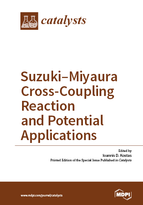Suzuki–Miyaura Cross-Coupling Reaction and Potential Applications
A special issue of Catalysts (ISSN 2073-4344). This special issue belongs to the section "Catalytic Materials".
Deadline for manuscript submissions: closed (30 November 2016) | Viewed by 103848
Special Issue Editor
Interests: transition metal homogeneous catalysis in organic synthesis; catalysis by metal nanoparticles; medicinal chemistry
Special Issues, Collections and Topics in MDPI journals
Special Issue Information
Dear Colleagues,
Suzuki–Miyaura cross-coupling remains a powerful tool in organic synthesis for C–C bond formation and has various industrial applications, such as for the synthesis of pharmaceuticals and materials. Intensive research efforts are being made into finding ways of improving and expanding the scope of this process, and the development of more efficient catalytic systems for this extremely important reaction is still a hot research topic of enormous academic and industrial interest.
This Special Issue aims to cover promising research and novel trends in the broad field of Suzuki–Miyaura cross-coupling, employing a range of different catalysts. Catalysis may be homogeneous or heterogeneous, and the transformations may be in mono- or biphasic systems, using conventional conditions or by application of non-conventional techniques (e.g. ultrasound, microwaves). The catalysts may be supported or unsupported metal complexes with phosphane- or phosphane-free ligands, as well as metal nanoparticles. Studies on catalyst recycling, coupling of non-activated substrates, mechanistic insights, and also potential applications for the synthesis of fine chemicals and intermediates used in the manufacture of drugs and materials would also be of great interest.
Dr. Ioannis D. Kostas
Guest Editor
Manuscript Submission Information
Manuscripts should be submitted online at www.mdpi.com by registering and logging in to this website. Once you are registered, click here to go to the submission form. Manuscripts can be submitted until the deadline. All submissions that pass pre-check are peer-reviewed. Accepted papers will be published continuously in the journal (as soon as accepted) and will be listed together on the special issue website. Research articles, review articles as well as short communications are invited. For planned papers, a title and short abstract (about 100 words) can be sent to the Editorial Office for announcement on this website.
Submitted manuscripts should not have been published previously, nor be under consideration for publication elsewhere (except conference proceedings papers). All manuscripts are thoroughly refereed through a single-blind peer-review process. A guide for authors and other relevant information for submission of manuscripts is available on the Instructions for Authors page. Catalysts is an international peer-reviewed open access monthly journal published by MDPI.
Please visit the Instructions for Authors page before submitting a manuscript. The Article Processing Charge (APC) for publication in this open access journal is 2700 CHF (Swiss Francs). Submitted papers should be well formatted and use good English. Authors may use MDPI's English editing service prior to publication or during author revisions.
Keywords
- Cross-coupling
- C-C bond formation
- Noble metals
- Homogeneous catalysis
- Metal complex
- Phosphane ligand
- Phosphane-free ligand
- Multiphase catalysis
- Heterogeneous catalysis
- Metal nanoparticles






